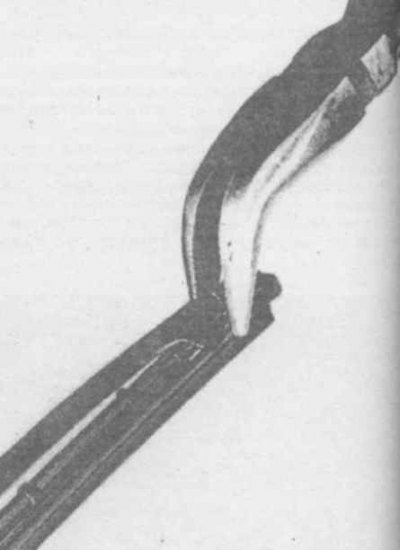General information
1. Air conditioning hoses are checked and changed only at a car service.

10.2 Removing the scraper from the brush holder
2. Under the influence of high temperatures inside the engine compartment, the rubber and plastic hoses gradually harden and destroy, ensuring the operation of various engine components. You should periodically check the condition of the hoses, the presence of cracks and hardening, loose connections, leaks. The procedure for checking the cooling system hoses is described in section 9.
3. Part of the hoses are attached with clamps. Check the tightness of the clamps, as loosening the fastening leads to a leak. In those places where clamps are not provided, check the reliability of the hose seal on the fittings, loss of elasticity in such connections due to swelling or hardening of the hoses is not allowed, otherwise the tightness of the connection is violated.
Vacuum hoses
4. Vacuum hoses can be distinguished by their color, or by the colored strips glued to them. Vacuum hoses with different wall thicknesses, atmospheric compression resistance and heat resistance are used for different engine systems. When replacing, make sure that the new vacuum hoses exactly match the ones being replaced.
5. Often the hose can only be checked after it has been removed from the vehicle. If several hoses are being removed, first mark the mating fittings and hoses so as not to disturb their relative position later.
6. At check of a condition of vacuum hoses at the same time examine also plastic tees. Check for cracks on them, as well as deformation of the hose at the point of contact with the tee fitting, which may be the cause of a leak.

12.1 Height (h) and free running (A) brake pedals
1. Pusher; 2. Stop signal switch; 3, 4 - Locknut; 5. Gender
7. To check for leaks, listen through a piece of hose with an internal diameter of about 6 mm, attaching the hose to the place to be checked. characteristic "hiss" indicates a leak.
Fuel hoses
8. Check the condition of the rubber fuel hoses for damage.
9. When replacing the fuel line on injection engines, the new line must exactly match the one used in the fuel system of engines of this type.
10. When replacing hoses, always install screw clamps.
Metal tubes
11. Metal tubes are commonly used in the fuel line to connect the fuel pump to the fuel pressure regulator at the injector rail. Check the tubes for twisted sections and small incipient cracks.
12. Replace only with seamless steel tubing. Tubes made of copper or aluminum are not suitable, as they cannot withstand vibration loads from the engine.
13. Check the condition of the metal pipes and fittings of the hydraulic brake drive system at the junctions with the main brake cylinder and the dispenser; cracks and loose connections are not allowed.